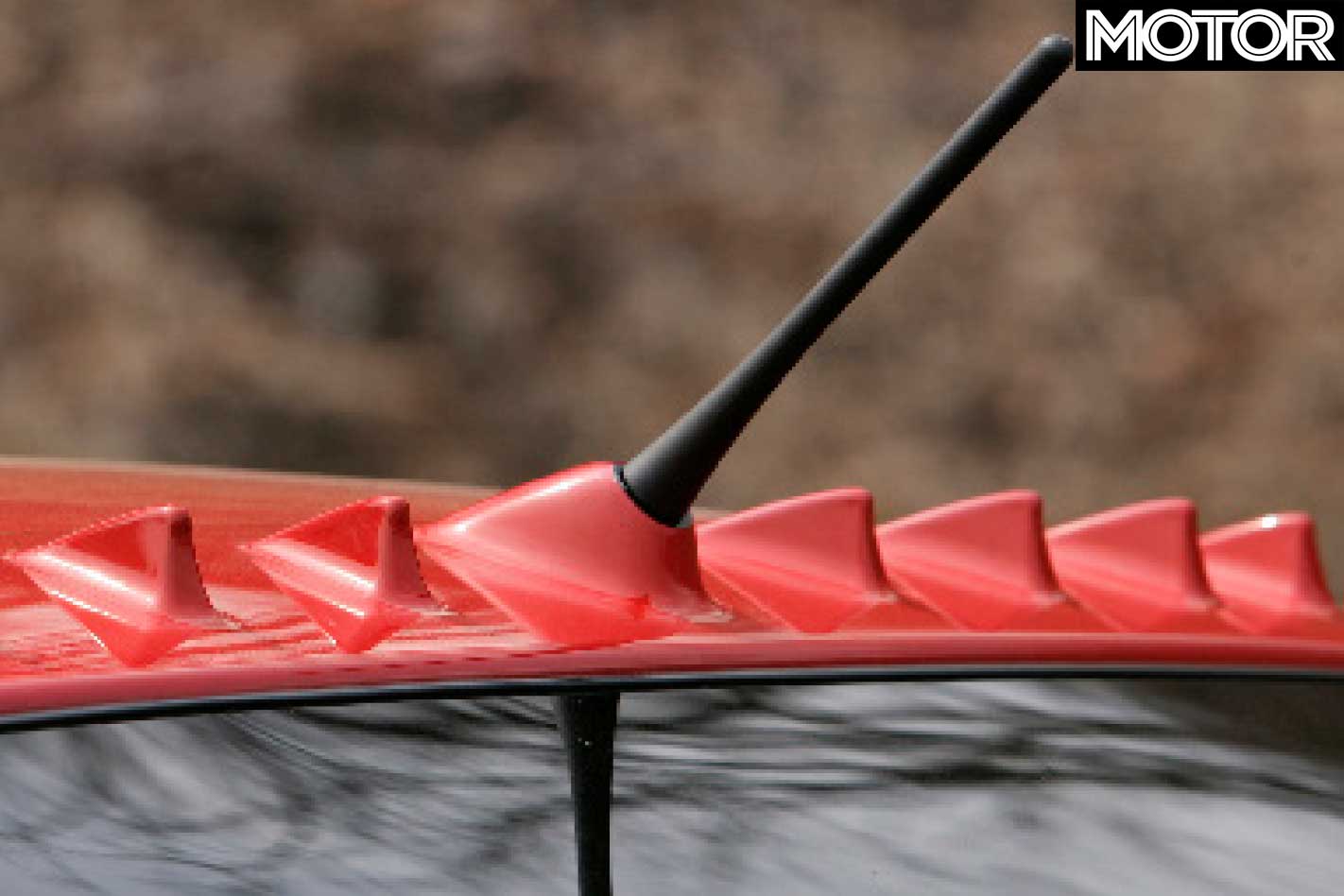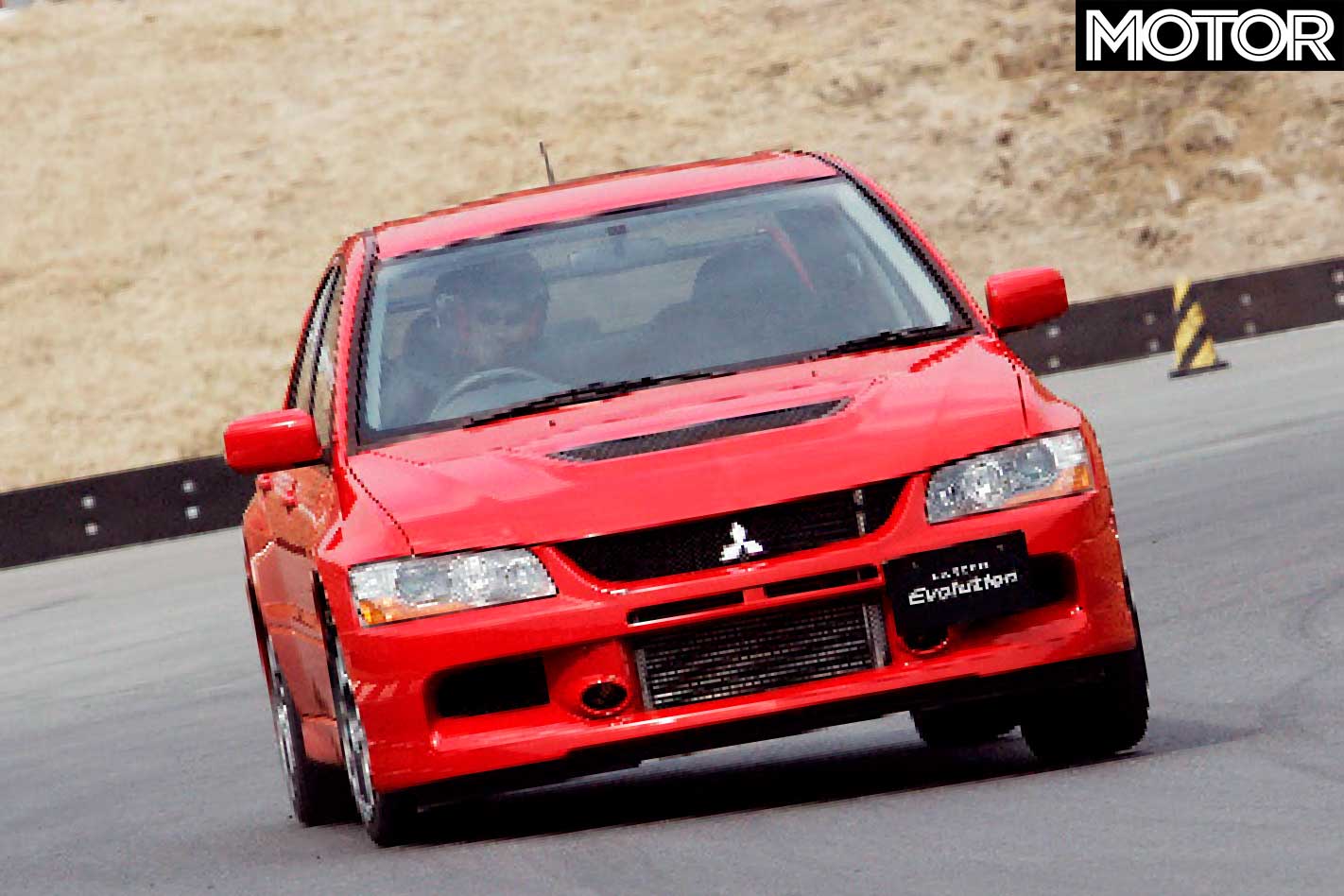Generally, rival makes aren’t that welcome at new car launches. So when I pulled up at the front gate of Fuji Speedway in a WRX STi, and yelled out: “we’re here for the Mitsubishi test drive,” the approaching security guard seemed reluctant: “You’re not planning to take that thing out on the track with the EVO are you?”
This feature was originally published in MOTOR’s May 2005 issue
“No worries mate, we’ve cleared it with Mitsubishi,” was our instant response. Maybe I’ve got an honest face, or maybe it was the shock of an Aussie speaking his lingo, but he opened the gate straight away.
Once in, we headed down to the new short track behind the fully redesigned $250-million circuit and grandstand. Sitting in the pits, all red and raging, was the new Lancer Evolution IX, the most radical EVO since the brand surfaced just over a dozen years ago. For its new 2005 Lancer, Mitsubishi has fiddled with the engine and replaced the suspension, tweaked the turbo, and given it a more aggressive look.
Checking out the EVO’s re-styled front end, I couldn’t help but notice the tell-tale Boulay nose was gone. The Mitsu spin doctor explained that when ex-design chief Olivier Boulay left the company, Mitsubishi went back to the drawing board for a simpler look (here’s hoping the upcoming Magna will get similar treatment).
The mesh grille might have been a simple Etch-a-Sketch jobbie but the re-styled front bumper and cooling ducts have clearly taken some thought, as have the rear diffuser and the row of eight shark’s teeth-like protrusions evenly spaced above the rear window. Apparently these roof vanes are a vortex generator that helps reduce drag and optimise the downforce created by the rear wing.

Inside, the EVO IX’s Recaro seats offer even more side and lumbar support than those of it predecessor. The bolsters cop non-slip alcantara that keeps you stuck in place. To that end, the STi’s seats lack sufficient support, especially around the edges, which are too spongy. In contrast to the EVO IX’s poor quality plastics and taxi-like interior, the STi offers acceptable plastics and a user-friendly dash design.
All that aside, the biggest modification to the EVO IX, or indeed any EVO since 1992 is the addition of MIVEC technology to the long-lived 4G63. Short for Mitsubishi Innovative Valve timing and lift Electronic Control, the 2.0-litre turbo now features variable cam timing for increased flexibility.
At engine speeds under 3500rpm it automatically adjusts itself to deliver instant throttle response, while at higher speeds, MIVEC spreads the power delivery throughout the entire power band by allowing more air into the combustion chambers.

However, ultimate power and torque figures remain the same as the outgoing Japanese-spec EVO VIII, with the 2.0-litre pumping out 206kW at 6500rpm and 400Nm at 3000rpm. That’s what the car makers say. The truth is that both production versions of the EVO and STi are producing upwards of 220kW.
The main difference with the EVO’s new MIVEC is where peak torque is made. With a fair dollop of low-down urge from 2000rpm, the EVO IX delivers maximum torque from a low 3000 through to 4500rpm, and that makes for serious punch out of corners.
The new engine’s power band is also perfectly matched to the notchy six-speed gearbox. Where you might quiz over the right ratio, the extra herbs way down low give you the latitude to stay in third, and still come out of the corner like a raging bull.

Boasting identical power as the EVO IX, the WRX STi’s 2.0-litre four-pot turbo generates a meatier 412Nm at 4400rpm, but in a body that weighs some 50kgs more than the EVO. So the torque advantage is all but cancelled out. Around 90 percent of peak torque is on tap from 2700rpm, hitting its max at 4200rpm.
While the torque curve is not as flat as the EVO’s, if you can keep the STi on the boil between 2700 and 4500rpm you’ll be able to give the EVO a real run for its money.
The STi’s six-speed gearbox is also a gem and offers a nice tight gate with relatively short throws. A quick 0-100km/h sprint comparo on my stopwatch had the EVO’s 4.5secs just pipping the STi’s 4.6secs, remembering of course that in Japan, the standard fuel is 100 RON octane.

The EVO’s other major modification was to its suspension. Carried over from the EVO VIII MR version of last year, the EVO IX employs Bilstein dampers at each corner with struts at the front and a multi-link set-up at the rear. Fitted as standard to the STi, the Bilsteins fitted to the EVO improve ride quality out of sight. The new setup also aids the EVO’s already considerable cornering prowess.
A further tweak to the suspension is a 5mm drop in the rear ride height, which assists in transferring the EVOs bottom-end urge onto the tarmac, while also enhancing the response of its secret cornering weapon, Super AYC (Active Yaw Control).
Mitsubishi says that they’ve stayed away from fiddling with the EVO VIII MR’s combination of Super AYC, ACD (Active Centre Diff) and ABS for the EVO IX, but that the simple fact of altering the ride height has resulted in a better fit of the puzzle’s pieces.

At the limit, the EVO devours corners turning in sharply and holding the line without a sniff of understeer. Wanna get lairy? Jump on the brakes, get the weight forward, turn in, get back on the gas and wait for the techno wizardry to do the rest. Go in extra hot and you’d better be ready for loads of sideways stuff as the traction control works overtime to keep you on the tarmac. And that’s the beauty of this car.
Sitting on sticky Yokohama Advan A046 tyres and employing four-piston Brembo brakes at the front, the EVO is endowed with the sort of grip that only the ham-fisted can overcome. It covers for your overzealousness by transferring torque forward and aft and left and right, in a micro-second, as and when it’s needed to get you around the corner and back.
The STi is a little more challenging. With steering that’s a touch heavier than the EVOs, you have to balance the STi perfectly, wiping off excess speed with the huge four-pot Brembos. Then, after you’ve shed speed, tuck the front-end into the corner allowing the rear to come around. Even though you’re relying on its grippy Potenza RE070 rubber to maintain your desired line, the STi can still languish into understeer when pushed.

However, switch the DCCD button on the centre console to manual and channel 65 percent of the torque to the rear, and the STi becomes a different beast. It becomes much easier to drive at the limit with more positive tail movement helping you to get through the twisties. At the end of the day, being faster isn’t enough. Around the 1km short track at Fuji, both cars clocked identical times.
On the track, I’d choose the EVO IX for its bag of cornering tricks, that said, the steering feels twitchy and arcade-like. In the real world, though, the STi is more involving and has a better ride quality, making the Subaru our choice, if only by a whisker.
As I left Fuji, the security guard asked what the result on the track was. I replied that the EVO IX had won. He said, “Thought so.” But I didn’t add that I was glad to be taking the Suby home.
Fast Facts

| u00a0 | Subaru Impreza WRX STi | Mitsubishi Lancer Evolution IX |
| Body | 4-door sedan | |
| Drive | all-wheel | |
| Engine | 2.0-litre DOHC 16-valve turbo flat-four | 2.0-litre DOHC MIVEC 16-valve turbo inline four |
| Bore x Stroke | 92.0mm x 75.0mm | 85.0mm x 88.0mm |
| Power | 206kW @ 6400rpm | 206kW @ 6500rpm |
| Torque | 412Nm @ 4400rpm | 400Nm @ 3000-4500rpm |
| Power/Weight | 140kW/tonne | 146kW/tonne |
| Transmission | 6-speed manual | |
| Weight | 1475kg | 1410kg |
| 0-100km/h | 4.60sec | 4.50sec |
| Top speed | 250km/h | 255km/h |
| Suspension (f) | MacPherson struts, coil springs, anti-roll bar | |
| Suspension (r) | multi-link, coil springs, anti-roll bar | |
| L/W/h | 4415/1740/1440mm | 4490/1770/1450mm |
| Wheelbase | 2540mm | 2625mm |
| Tracks | 1490mm (f); 1495mm (r) | 1515mm (f); 1515mm (r) |
| Brakes (f) | 326mm ventilated discs, four-piston calipers | 323mm ventilated discs, four-piston calipers |
| Brakes (r) | 316mm ventilated discs, single-piston calipers | 305mm ventilated discs, two-piston calipers ( |
| Wheels | 17 x 7.5-inch (f & r), allo | 17 x 8.0-inch (f & r), alloy |
| Tyre Sizes | 225/45 R17 (f & r) | 235/45 R17 (f & r) |
| Tyres | Yokohama Advan AO46 | Bridgestone Potenza RE070 |
| Price | $56,630 | $59,990 (est) |





